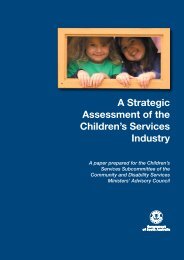Global Study On Child Poverty And Disparities (PDF) - Social Policy ...
Global Study On Child Poverty And Disparities (PDF) - Social Policy ...
Global Study On Child Poverty And Disparities (PDF) - Social Policy ...
Create successful ePaper yourself
Turn your PDF publications into a flip-book with our unique Google optimized e-Paper software.
Education appears to be a stronger factor than<br />
wealth in influencing variations in outcomes.<br />
Thus, is appears that some children may suffer<br />
from malnutrition not due to lack of food but due<br />
to lack of awareness of good nutrition. Therefore,<br />
concerted efforts are needed to raise people’s<br />
awareness of the importance of children’s and<br />
mother’s health and nutrition.<br />
Breastfeeding practices appear to be relatively<br />
better than overall nutrition practices, as the<br />
youngest infants (many exclusively breastfed)<br />
have better overall nutrition status than older<br />
groups. About 40 per cent of children age 0-5<br />
months are exclusively breastfed and considered<br />
to be adequately fed. Continued breastfeeding at<br />
ages 9-11 months and related positive nutrition<br />
outcomes were significantly higher in rural areas.<br />
This study was not able to assess the contribution<br />
of the Breastfeeding <strong>Policy</strong> to these outcomes.<br />
Given the nutritional outcomes found in the<br />
MICS, it is disappointing to see that nutritional<br />
policy is not a higher priority in the health sector<br />
policy. The high levels of moderate and severe<br />
malnourishment of children 12 to 59 months,<br />
across all geographic regions and economic<br />
quintiles, indicate the importance of improving<br />
nutrition education.<br />
Health outcomes<br />
The geography of Vanuatu, with a population<br />
scattered throughout many islands, presents a<br />
tremendous challenge for resource allocation,<br />
health facility distribution and service delivery.<br />
Data from 2005 indicate that about 20 per cent<br />
of the population does not have access to health<br />
services (Vanuatu National Health Accounts<br />
team, 2007). Some health indicators show<br />
improvements in recent years, such as improved<br />
prenatal care and attendance at births by trained<br />
health workers.<br />
National laws, policies and<br />
programmes<br />
The Health Sector <strong>Policy</strong> 2009-2015 aims to<br />
achieve the MDGs and improve access, quality<br />
and capacity to deliver services. Primary health<br />
care is the pre-eminent concern. The Ministry of<br />
Health intends to track a number of indicators<br />
of progress, including the infant mortality ratio,<br />
the number and causes of maternal deaths by<br />
province, the proportion of deliveries attended by<br />
skilled attendants by province, under-five mortality<br />
by cause, and the proportion of people with<br />
access to safe water and proper sanitation in rural<br />
communities. Other program indicators related to<br />
tuberculosis and malaria also still remain in place.<br />
Planning Long, Acting Short articulates four<br />
health goals: (1) strengthening the capacity of the<br />
Ministry of Health; (2) strengthening the delivery<br />
of basic health services to all, in remote, rural<br />
and urban areas; (3) vigorously controlling and<br />
progressively eliminating malaria from Vanuatu<br />
and (4) investing in training and supporting the<br />
health workforce, particularly nurses in rural<br />
facilities.<br />
The National <strong>Child</strong>ren’s <strong>Policy</strong> and its Monitoring<br />
and Evaluation Framework also set a number<br />
of goals: developing indicators for health, water<br />
and sanitation programmes by 2010; improving<br />
reporting on child births and deaths; establishing<br />
a malaria surveillance information system by<br />
2010; and ensuring that 80 per cent of health staff<br />
were able to conduct basic nutrition education in<br />
schools by 2010. There were also calls for a 20<br />
per cent increase in the health budget for youthrelated<br />
activities in the provinces by 2011 and<br />
a revised Primary Health Care <strong>Policy</strong> by 2010,<br />
as well as improvements to maternal health.<br />
Indicators for these outcomes include 80 per cent<br />
compliance by health care professionals with<br />
antenatal protocols by 2010, and a measurable<br />
increase in contraceptive services linked to<br />
immunisation and maternal health with family<br />
planning.<br />
The Ministry of Health Maternal and <strong>Child</strong> Health<br />
Programme provides immunisation, antenatal<br />
care and contraception, as well as information and<br />
advice on parenting, child health development,<br />
maternal health and well-being, child safety,<br />
breastfeeding, nutrition and birth spacing. In 2006,<br />
61 per cent of reported births took place in health<br />
clinics and 29 per cent in hospitals, while 7 per<br />
cent were attended by traditional birth attendants<br />
(ADB 2009a).<br />
As noted earlier, health as a proportion of total<br />
national expenditure has maintained an average<br />
share of over 10 per cent since 2001. The main<br />
source of health expenditure is the Ministry<br />
of Health budget. There are insufficient data<br />
available to determine what proportion of this total<br />
spending is directed to children’s health, but in<br />
2005 about 3.2 per cent of Government health<br />
spending (0.6 per cent of GDP) was directed to<br />
reproductive health and maternal care (Vanuatu<br />
National Health Accounts team, 2007).<br />
A major concern is the wide disparity in outcomes<br />
for children in different areas, especially between<br />
urban and rural communities. This mirrors the<br />
limited access to health services in rural areas.<br />
56
















